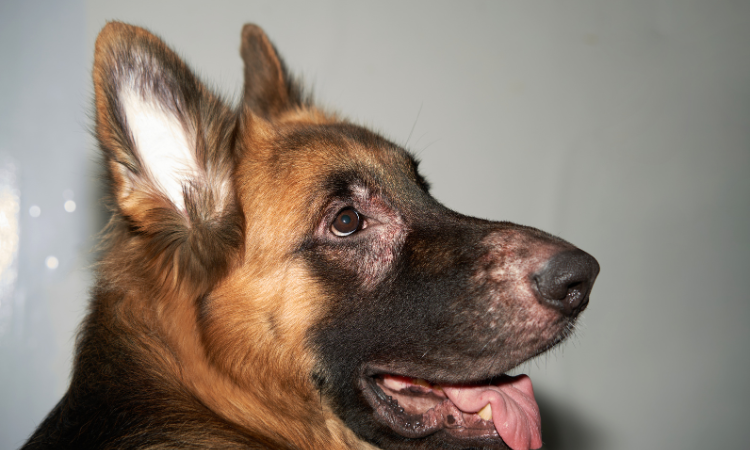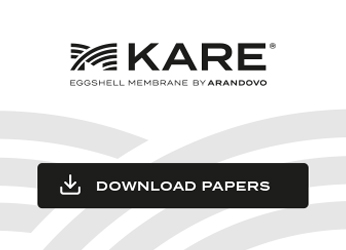The skin is the largest organ of a dog’s body and acts as its first line of defense against the outside world. However, due to their constant exposure to various elements, dogs can be affected by a variety of skin diseases throughout their lives.
At Arandovo, we have prepared this comprehensive guide in which we will review some of the most common skin diseases affecting dogs: pyoderma, atopic dermatitis, fungal infections and mange, along with their symptoms and treatments.

What is pyoderma and how does it affect dogs?
Pyoderma is a common bacterial infection in dogs which affects their skin. It is characterized by the presence of pustules, redness, inflammation and itching. This condition can be either superficial or deep, depending on the severity of the infection and the layers of skin affected.
Dogs with pyoderma will often show signs of discomfort, such as scratching, excessive licking or biting of affected areas. In addition, they may develop patches of scaly skin, hair loss and foul odor.
Treatment of pyoderma usually involves the use of topical or systemic antibiotics to eliminate the bacterial infection. In addition, it is important to address any underlying causes that may be contributing to the development of pyoderma, such as allergies, parasites or underlying diseases.
Dogs with atopic dermatitis: symptoms and treatments
Atopic dermatitis is a chronic skin condition that affects many dogs worldwide. This disease develops as an allergic response to various environmental substances, such as pollen, dust mites and fungi. Although atopic dermatitis can manifest in any dog breed, some of them are more genetically predisposed than others, such as Bulldogs, Boxers and Terriers.
Symptoms of atopic dermatitis in dogs
● Persistent itching
One of the most common symptoms of atopic dermatitis in dogs is intense and constant itching. Affected dogs tend to scratch, lick and bite the affected skin in an attempt to relieve the discomfort.
● Reddening of the skin
The skin of dogs with atopic dermatitis may become red and irritated, especially in areas such as the armpits, groin, belly, paws and face.
● Inflammation
Inflammation is another common symptom of atopic dermatitis in dogs. The affected skin may appear swollen and tender to the touch.
● Peeling
Skin affected by atopic dermatitis may become dry and scaly, which can lead to flaking and crusting.
● Secondary infections
Due to excessive scratching and skin irritation, dogs with atopic dermatitis are at increased risk of developing secondary bacterial and fungal infections.
Treatments for dogs with atopic dermatitis
● Antihistamine medications
Antihistamines can help reduce the itching and inflammation associated with atopic dermatitis by blocking the action of histamine, a chemical released during an allergic reaction.
● Steroids
Steroids, both topical and systemic, may be prescribed by a veterinarian to control inflammation and severe itching in dogs with atopic dermatitis.
● Medicated baths
Baths with medicated shampoos can help relieve itching, reduce inflammation and remove allergens from the dog’s skin. Shampoos containing ingredients such as colloidal oatmeal, salicylic acid or essential oils may be beneficial.
● Immunotherapy
Immunotherapy, also known as allergy shots, may be a treatment option for dogs with chronic atopic dermatitis. It consists of regular administration of small amounts of the triggering allergen to help the dog’s immune system develop a tolerance to the substance.
● Environmental control
Reducing the dog’s exposure to environmental allergens, such as pollen and dust mites, can help minimize the symptoms of atopic dermatitis. This may include keeping the dog’s environment clean, using air purifiers, and avoiding contact with known allergens whenever possible.
● Food supplements
Natural pet food supplements such as MKARE®️ help to keep not only their coat shiny and in perfect condition, but also help to protect the health of cartilage, tendons and ligaments, for example.
Everything about fungal dermatitis in dogs
Fungal dermatitis, also known as dermatophytosis, is a common fungal skin infection affecting dogs. It is characterized by the presence of circular patches of red, scaly, itchy skin that can spread over time.
The fungi responsible for dermatitis in dogs are usually of the Microsporum or Trichophyton genus, and can be transmitted through direct contact with other infected animals, contaminated soil or contaminated equipment.
Treatment for dogs with fungal dermatitis usually involves the use of topical or systemic antifungal medications, along with measures to disinfect the dog’s environment and prevent the spread of infection to other animals or humans.
Identifying and treating mange in dogs
Mange is a skin disease caused by parasitic mites that infect the animal’s epidermis. It occurs in several forms, the most common being sarcoptic mange and demodectic mange.
Sarcoptic mange is highly contagious and can be transmitted between dogs and other animals, as well as to humans.
Demodectic mange is caused by a mite that normally lives on a dog’s skin without causing problems, but can multiply and cause health problems if the dog’s immune system is compromised.
Symptoms of mange in dogs can vary depending on the type of mite and the severity of the infection, but generally include intense itching, hair loss, skin redness, skin lesions and scabs.
Treatment for mange in dogs may involve the use of topical or systemic medications to kill the mites, as well as measures to relieve itching and prevent secondary skin infections.
MKARE®️, natural food supplements for dogs
At Arandovo, we have developed MKARE®️, a 100% natural functional ingredient based on eggshell membrane that natively contains elastin, chondroitin sulfate, collagen, hyaluronic acid and over 400 proteins with multiple benefits not only for dogs, but for pets in general.
Thanks to MKARE®️, your pet’s skin and coat will be in perfect condition, helping to prevent or make skin diseases less serious and less annoying. In addition to the skin, MKARE®️ also helps improve joint mobility, reduces pain and inflammation, strengthens cartilage, bone and ligaments, and helps maintain healthy muscles.
Skin diseases in dogs can be a source of discomfort and unrest for your pet. However, with the right treatment and the right products such as MKARE®️, it is possible to alleviate symptoms and promote a healthy, happy skin for your canine companion.
It is important to remember that treating atopic dermatitis in dogs may require a multimodal approach and close collaboration with a veterinarian. In addition, it is critical to provide regular skin care and follow your veterinarian’s recommendations to help control symptoms and improve your pet’s quality of life.
If you want to know more about MKARE®️ and how it can help in the daily life of your pet, check out our website now or get in touch with us, we will solve all your doubts.




